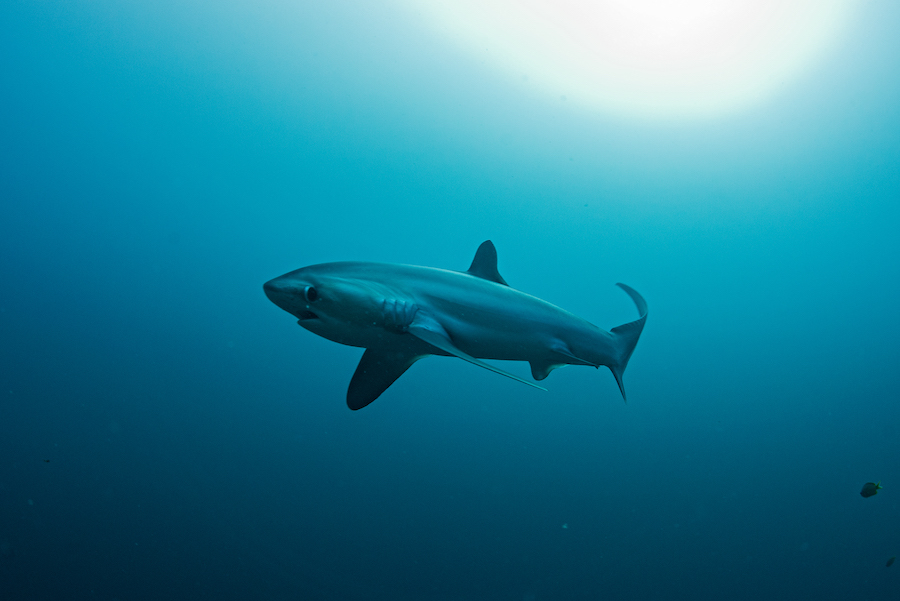Thresher sharks are lamniform or mackerel sharks that are easily identified by their long, thresher-like tail or fins. They have generally small mouth, cone-shaped nose, and they come in different sizes and colors depending on their species.
Types of Thresher sharks
There are three known species of thresher sharks. These include the common thresher, the big-eye thresher, and the pelagic thresher.
- Common thresher (Alopias vulpinus) – the largest of the three species that could measure up to 20 feet in length and over 500 kilograms in weight. The dorsal surface or back surface of their body is usually dark green in color.
- Big-eye thresher (Alopias superciliosus) – the second largest of the species with length that could reach 16 feet with a dorsal color of brown.
- Pelagic thresher (Alopias pelagicus) – the smallest of the species that measure about 10 feet in length with a usual dorsal color of blue.
Hunting and food
Thresher sharks love to hunt in open seas with squids, octopuses, crustaceans, and pelagic schooling fish as their favorite preys, as well as mackerel, bluefish, needlefish, lanternfish, and juvenile tuna. They are said to use their long tails to blow and stun their preys before eating them. They are sometimes observed “breaching” or powerfully jumping out of the water preying on seabirds.
Habitat
Thresher sharks are primarily pelagic. They dwell in deep open oceans and seas, but also venture in shallow waters of coastal seas. The common threshers are usually found in continental shelves, especially those along North America and Asia of the North Pacific. The big-eye and pelagic thresher sharks are more commonly seen in the Central and Western pacific.
Thresher Shark
Thresher sharks, particularly the pelagic thresher sharks, are also seen in the Philippine seas. They are seen in Monad Shoal, Malapascua Cebu, Philippines. The Monad Shoal is an underwater island at 16-32 meters with a 200-meter drop on its sides. The pelagic thresher sharks usually hunt in the deep and go over the sunken island early in the morning for some cleaning sessions. The Moon Wrasse and the Blue Wrasse particularly do the cleaning on the Thresher sharks.
Thresher shark feeding on these smaller cleaning-fishes of the shoal have not been observed. It is said that thresher sharks do not eat them; instead, they have a mutual relationship with these fishes as they clean the bodies of the thresher sharks.
Thresher sharks in Malapascua
Malapascua is a small island in the northern tip of Cebu, Philippines. It is the only place in the Philippines, if not in the whole world, where you get to encounter thresher sharks.
You can reach Malapascua by taking a plane to Cebu City. From Cebu City, you can take a bus or rent a van going to Maya in the town of Daanbantayan. The travel takes around 4 hours to get to the tip of northern Cebu. From the port of Maya, a motorized boat or “banca” will take you to the island of Malapascua for about 30minutes.
Thresher Shark Diving
Almost every day, sightings of thresher sharks happen in Monad Shoal in Malapascua. Thresher shark divers usually start off early as these sharks are seen to go up the sunken island early in the morning, between 6 to 9 in the morning.
Thresher sharks are solitary and shy in nature. They are afraid of bubbles and other sudden movements. It is suggested that you stay still once you spot them to have a good chance of having a close encounter with the thresher sharks.
Nitrox diving is also recommended on your thresher shark dive due to the depth of your dive and the duration of your stay underwater waiting for the thresher sharks to come by.
Thresher Shark Video
Thresher sharks are abundant and famous in Malapascua. Thresher sharks are often seen at Monad Shoal in Malpascua. Watch a 47-second video of a thresher shark in Malapascua, filmed by Sven and Fabienne of Ocean Vida Beach and Dive Resort. Enjoy!




